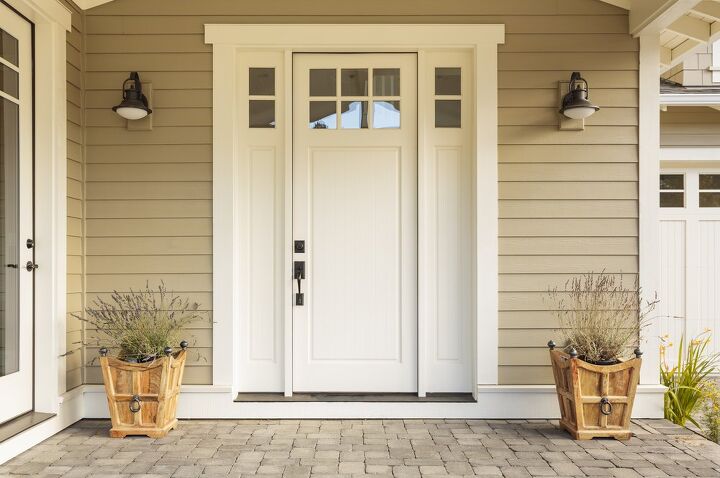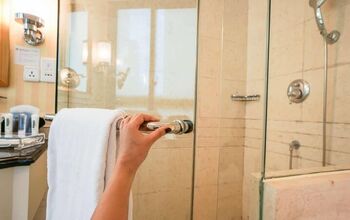11 Types Of Door Sweeps (With Photos)

There is nothing worse than a gap in your door that lets pests and cold air in, and warm air out. It can increase your energy bills and make life uncomfortable when bugs enter your home unwanted. You have probably heard that door sweeps can solve this problem, but what are the main types of door sweeps?
Brush, tubular, flat, and L-shaped door sweeps are the most common varieties. Door sweeps made of rubber, foam, neoprene, and vinyl are all effective and can prevent bugs from entering the home. Self-stick door sweeps and weatherstripping are the easiest ways to seal gaps in your door and increase energy efficiency.
Door sweeps cost an average of $40, but they can cost as little as $20. It is easy to install door sweeps on your own, and the type that you need depends on your door. Follow along as we take a look at each of the types of door sweeps and see which best suits you.
Do You Need Hardware, Latches and Tracks Repair or Replacement?
Get free, zero-commitment quotes from pro contractors near you.

Door Sweep Types
Door sweeps are a critical part of pest protection and energy efficiency if you have a gap in your door. You can keep cold air out of your home with door sweeps, and keep the warm air in. It is tricky to pick the type of door sweep that you need unless you know how they each differ.
1. Brush
Brush door sweeps get their name from the bristles that hang down and prevent temperature loss. You install brush door sweeps on the exterior of a door and they are great for keeping bugs out of the house. They are common and easy to install, but brush door sweeps are among the least efficient options.
That is because the bristles can easily take on damage and wear down over time. You can always replace your brush door sweep, but you can’t guarantee how long it will last. Brush door sweeps carry a bonus of keeping dirt out of the crack in your door.
2. Tubular
Tubular door sweeps are highly efficient because they create a seal on each side of your door. That means that you have added energy efficiency and can more easily stave off pests. The main downside to tubular door sweeps is that they can be a bit of an eyesore.
It is common to find tubular door sweeps on doors inside and outside of the house. Tubular door sweeps are the easiest to install, but they lack longevity. Luckily, tubular door sweeps are cheap to replace, and you can install them quickly.
3. Neoprene
Neoprene is a type of rubber that works well as a door sweep. Tough rubbers such as neoprene are ideal to use as a door sweep because of how durable they are. As long as temperatures don’t exceed 200 degrees Fahrenheit, your neoprene door sweep shouldn’t expand, shrink, or warp.
Neoprene door sweeps can be cut to fit your doorway, or you can buy precut lengths of them. You can install neoprene door sweeps on your and attach them to the door with screws. Neoprene door sweeps will help prevent temperature and energy loss, as well as keep pests out.
4. Flat
Flat door sweeps are a large category, and you can find them in many materials. Many homeowners find them more appealing than tubular and brush sweeps because flat sweeps are less noticeable. Professional installation is ideal because it can be tricky to install flat door sweeps, but DIY homeowners can get it done.
Nylon and silicone flat door sweeps are the most durable, but flat vinyl door sweeps are strong and affordable. They are just as functional as tubular door sweeps, but flat door sweeps are more visually appealing.
5. Weatherstripping
Weatherstripping is less visually appealing than traditional door sweeps, but it can efficiently seal gaps. You can cheaply weatherstrip doors, but you can never count on weatherstripping to last as long as traditional door sweeps. It is possible to weatherstrip a door for $12 or less, but you may need to replace it frequently.
You can even weatherstrip a double-entry door, and it is worth the cost and time. However, you may want to consider flat or round door sweeps if you don’t want to have to reseal the door often.
6. Self-Stick
Self-stick door sweeps are the best option if you want to quickly install one on your own. As the name suggests, you can simply slap a self-stick door sweep into place and reap the benefits. They are the perfect temporary solution while you finish out a lease or simply if you want to wait to install an alternative.
They aren’t as effective as automatic, tubular, or flat door sweeps, but they can effectively seal a gap. You can install self-stick door sweeps in under 5 minutes, and they are only compatible with wood or metal. Peel the back off of the plastic strip and press it directly against the bottom of the door to quickly seal a gap, increase energy efficiency, and discourage pests.
7. Automatic
Automatic door sweeps, or door bottoms, are among the most advanced and effective options. Each time that you open and close the door, an automatic door sweep creates a seal on its own. Automatic door sweeps work just as well against smoke and pests as they do at keeping cold air out.
You can expect to spend an average of $50 per automatic door sweep, and it is worth the cost. They are generally made out of aluminum and are durable, but water damage can weaken them.
8. Felt
Felt door sweeps are a type of weatherstripping that any homeowner can quickly install. They are long-lasting because felt is a durable material, and it is not flammable. You can close the gap in interior and exterior doors with a felt door sweep on your own in only a few minutes.
Felt can last up to 20 years but felt door sweeps last an average of 5 years. Exterior felt door sweeps may last less than 5 years if you live in an area with heavy and consistent rainfall. You can also use felt weatherstripping as a temporary solution if you are a renter or are considering another solution.
9. V-Strips
If you have a door with a small gap, then you might only need a V-strip. V-strips are made generally made out of metal, and they are easy to install. You can find rubber V-strips, and they are ideal if you expect a lot of rain.
V-strips are the perfect opportunity to seal a gap in your door without drawing attention. They are difficult to notice and don’t stand out, but V-strips are among the most effective types of door sweeps. You can seal up to 5 doors with V-strips for an average of $20 if you install them on your own.
10. L-Shaped
Homeowners specifically use L-shaped door sweeps for exterior doors. It is difficult to install L-shaped door sweeps and may require professional installation. However, they create a strong seal that keeps pests and cold air out, and warm air inside.
L-shaped door sweeps are not as noticeable as alternatives such as tubular sweeps. Consider an L-shaped door sweep if you want a discreet, dependable, and long-lasting solution for your door gap. You cannot use L-shaped door sweeps indoors, but they are the best option if you have a gap in an exterior door.
11. Foam
Foam stripping is unique because it works as a door sweep as well as a way to seal gaps in windows. It is similar to felt and rubber weatherstripping, but foam stripping is great in rainy climates. Much like felt door sweeps, foam stripping is simple, and you can install it without professional help.
The main advantage of foam sweeps is that it is thicker than felt. That comes in handy if your door gets a lot of use and foot traffic. You can get 2 rolls of foam sweeps for under $25, and that’s enough to seal several doors and windows.
Do You Need Hardware, Latches and Tracks Repair or Replacement?
Get free, zero-commitment quotes from pro contractors near you.

Related Questions
Do door sweeps keep bugs out?
Door sweeps can keep bugs out of your house, especially if they are flat or tubular. Nylon, foam, neoprene, and vinyl door sweeps can all prevent bugs from entering your home. They can also keep other pests, such as shrews and mice, out of your home.
Are door sweeps fire rated?
Yes, most door sweeps are fire-rated. Materials like aluminum, foam, and vinyl are all fire-resistant, and manufacturers generally state whether they are fire-rated or not. You don’t require a door sweep for a door to be fire-rated, however.
Should a door sweep touch the floor?
No, door sweeps should not directly touch the floor. Your door sweep should touch the door and the bevel and sit right above the floor. Some brush door sweeps may touch the floor if they hang down too far, but that is not ideal.
Related Articles

Nick Durante is a professional writer with a primary focus on home improvement. When he is not writing about home improvement or taking on projects around the house, he likes to read and create art. He is always looking towards the newest trends in home improvement.
More by Nick Durante




































